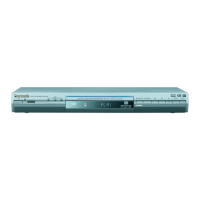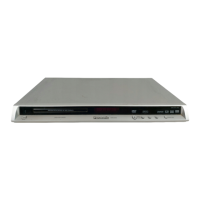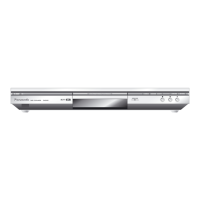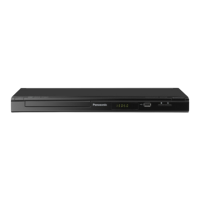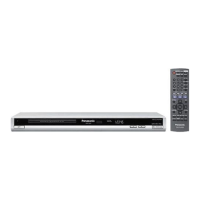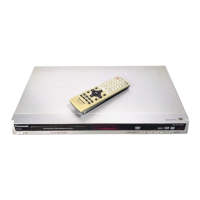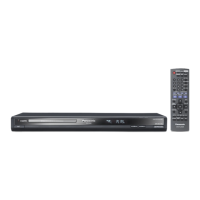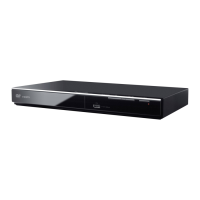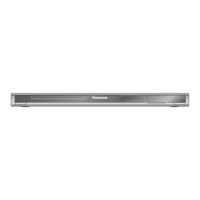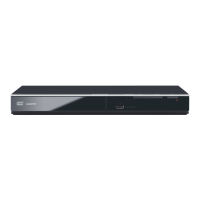RQT7258
12
Using On-Screen Menus
The items displayed will depend on the actual connection and disc.
∫ Play Menu
(Only when the elapsed play time can be displayed
[JPEG]: The Repeat and Marker functions can be used.)
∫ Picture Menu
123 4
Select the menu. Make the settings. Press to exit.
Main Menus
DISPLAY
ENTER
Select
Go to the next
menu
Register
Return to the
previous menu
123
456
789
0
10
ENTER
Register
Select
RETURN
Playback condition
Current playback number
Elapsed play time/Remaining time
Press [3 4] to change the display.
(Shows only elapsed play time for WMA, MP3 and SVCD.)
: Normal play
ALL: All group play [DVD-A]
PGM: Program play
Current position
Play mode
RND: Random play
PBC: Playback control play [VCD]
∫ Elapsed play time indicator
Program/Group
Title/Chapter
Track/Playlist
Content
To start from a specific item
Time
To skip incrementally or decrementally (Time Slip for play only)
1. Press [ENTER] twice to show Time Slip indicator.
2. Press [3 4] to select the time and press [ENTER].
≥Press and hold [3 4] to alter faster.
To start from a specific time (Time Search)
To change remaining/elapsed time display
Video
To display pixel number
Audio
(➜ page 9)
To display the current bitrate or sampling frequency
Still Picture
To switch still picture
Thumbnail
To show thumbnail images
Subtitle
(➜ page 9)
Marker (VR)
To recall a marker recorded on DVD-Video recorders
Angle
(➜ page 9)
Rotate Picture
Slideshow
To turn on/off slideshow
To change the slideshow timing (0–30 sec)
Other Settings
(➜ below)
Other Settings
Play Speed
(➜ page 8)
Repeat
Select an item to be repeated.
A-B
Repeat
To repeat a specified section
Press [ENTER] at the starting and ending points. Press
[ENTER] again to cancel.
≥[RAM] (still picture part): Does not work
Marker
Except [RAM]
To mark up to 5 positions to play again
Press [ENTER]. (The unit is now ready to accept
markers.)
To mark a position: [ENTER] (at the desired point)
To mark another position: [21] to select “¢”➜ [ENTER]
To recall a marker: [21] ➜ [ENTER]
To erase a marker: [21] ➜ [CANCEL]
≥
This feature doesn’t work during program and random play.
≥
Markers you add clear when you open the disc tray or
switch the unit to standby.
Picture
Mode
Normal
Cinema1:
Mellows images and enhances detail in dark scenes.
Cinema2:
Sharpens images and enhances detail in dark scenes.
Animation
Dynamic
User
(Press [ENTER] to select
“Picture Adjustment”
) (
➜
below)
Picture Adjustment
Contrast/Brightness/Sharpness/Colour (➜ page 7)
Gamma (Adjusts the brightness of dark parts.)
Depth Enhancer
Reduce the rough noise in the background to give a
greater feeling of depth.
MPEG DNR/3D-NR (➜ page 9, Reducing noise in
pictures)
Video
Output
Mode
With HDMI connection (When “HDMI Video Mode” is
set to “On”) (➜ page 15, “HDMI” tab)
Video recordings will be converted to, and output as, high
definition video. The picture quality will vary depending on
the connected equipment. Choose the picture quality to
your preference.
525 (480)p (progressive) 625 (576)p (progressive)
750 (720)p (progressive) 1125 (1080)i (interlace)
≥“¢” will be displayed next to those video outputs
possible with the connected equipment. Selecting an
item without “¢” can result in the picture being distorted.
Should the picture be distorted, press and hold
[CANCEL] until the picture is displayed correctly. The
setting will return to “525 (480)p” or “625 (576)p”.
≥Output from COMPONENT VIDEO OUT terminal will be
“525 (480)i” or “625 (576)i”.
With HDMI connection (When “HDMI Video Mode” is
set to “Off”) (➜ page 15, “HDMI” tab) or other
connections
525 (480)p (progressive) 625 (576)p (progressive)
525 (480)i (interlace) 625 (576)i (interlace)
When you select “525 (480)p” or “625 (576)p” and a
confirmation screen appears, select “Yes” only if
connecting to a progressive output compatible television.
Transfer
Mode
If you have chosen “525 (480)p”, “625 (576)p”, “750 (720)p”
or “1125 (1080)i” (➜ above), select the method of
conversion for video output to suit the type of material.
When the output signal is PAL
Auto: Detects 25 frame-per-second film content and
appropriately converts it.
Video:
Select when using Auto, and the video content is distorted.
When the output signal is NTSC
Auto1 (normal): Detects 24 frame-per-second film
content and appropriately converts it.
Auto2:
Compatible with 30 frame-per-second film content
in addition to 24 frame-per-second film content.
Video: Select when using Auto1 and Auto2, and the
video content is distorted.
HDMI
Colour
Space
With HDMI connection (When “HDMI Video Mode” is
set to “On”) (➜ page 15, “HDMI” tab)
The picture quality will vary depending on the connected
equipment. Choose the picture quality to your preference.
Should one of the items below not be possible with the
connected equipment it will not be displayed.
RGB YCbCr (4:4:4) YCbCr (4:2:2)
≥“HDMI RGB Range” (➜ page 15, “HDMI” tab) is
available when “RGB” is selected.
Using On-Screen Menus
Press once.
(When pressed twice, the
elapsed play time indicator
appears. ➜ below)

